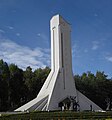


The Monument to the Peaceful Liberation of Tibet (Chinese: 西藏和平解放纪念碑) stands in the southern part of the Potala square in Lhasa, Tibet Autonomous Region just outside the protective zone and buffer zone of the World Heritage Site. It celebrates what the People's Republic of China calls the "Peaceful Liberation of Tibet" by the People's Liberation Army, or what the exiled Tibetan government calls the invasion and annexation of Tibet. The foundation stone was laid on July 18, 2001 by Hu Jintao, China's vice-president at the time. The monument was unveiled on May 22, 2002.
Structure
The US $1.7 million, 37-meter-high spire-like concrete structure was designed by Professor Qi Kang of the Southeast University in Nanjing, China. The monument abstractly portrays Mount Everest. The monument bears its own name engraved in the calligraphy of former general secretary and president Jiang Zemin, while an inscription refers to the expelling of "imperialist" forces from Tibet in 1951 (a reference to long-running Anglo-Russian Great-Game designs on the region) and reports on the socio-economic development achieved since then.
The southern side of the monument is inscribed with an inscription in both Tibetan and Chinese characters, of which the Chinese is as follows:
On May 23, 1951 A.D., the Agreement between the Central People's Government and the Local Government of Tibet on Measures for the Peaceful Liberation of Tibet was signed in Beijing. The People's Liberation Army marched into Tibet, expelled the imperialist forces, and Tibet was peacefully liberated. From then on, Tibet entered a new era of transition from darkness to light, from backwardness to progress, from poverty to affluence, from autocracy to democracy, and from feudalism to openness.
In 1959, Tibet quelled the rebellion, carried out democratic reforms, abolished the feudal serf system of unity of government and religion, and liberated millions of serfs who became masters of their own house. In 1965, the Tibet Autonomous Region was established, realizing regional ethnic autonomy and embarking on the road to socialism. After the reform and opening up of the country, the economy has developed rapidly, culture has become more and more prosperous, society is peaceful and progressive, and the people live and work in peace and contentment.
On the occasion of the 50th anniversary of the peaceful liberation of Tibet, we would like to erect this monument to commemorate the martyrs and show them to future generations.
Tibet Autonomous Region People's Government
July 18, 2001 A.D.
Gallery
-
 Left group of statues outside the memorial
Left group of statues outside the memorial
-
 The spire-like Mount Quomolongma (Everest)
The spire-like Mount Quomolongma (Everest)
-
 Right group of statues outside the memorial
Right group of statues outside the memorial
See also
References
- (in French) Décision-25COM X.B-Ensemble historique du Palais du Potala, Lhasa (Extension pour inclure la zone de Norbulingka (Chine), 2001 :
Regarding the 35 m high tower commemorating "the peaceful liberation of Tibet", the UNESCO mission verified that this new construction was well located outside the protection zones of the World Heritage site, on the south side of the New Potala Square.Concernant la tour de 35 m de haut commémorant « la libération paisible du Tibet », la mission UNESCO a vérifié que cette nouvelle construction était bien située à l'extérieur des zones de protection du site du patrimoine mondial, du côté sud de la Nouvelle Place du Potala.
- To Zhu Weiqun, Executive Vice Minister of the United Front Work Department of the Central Committee of the Chinese Communist Party, "The peaceful liberation of Tibet completed the liberation and unification of China's mainland and was a victory over imperialist forces and a few upper-class Tibetans who wished to split Tibet from China" » (Peaceful Liberation Ushers in a New Era Archived 2011-09-27 at the Wayback Machine, BEIJING REVIEW.com.cn, July 25, 2011.)
- Photo: "Chinese Vice-President Hu Jintao and other leading members of the central delegation bury the foundation stone of the 'Monument to the Peaceful Liberation of Tibet' at the foundation laying ceremony held on the Potala Palace Square in Lhasa, capital of the Tibet Autonomous Region, Wednesday July 18, 2001."
- Monument Erected to Commemorate Tibet Liberation, op. cit.: "A grand ceremony was held Wednesday in the Potala Palace in Lhasa to unveil the Tibet Peaceful Liberation Monument."
- "Fifity Years in Tibet". 2011-09-28. Archived from the original on 2012-04-01. Retrieved 2017-07-25.
{{cite web}}: CS1 maint: bot: original URL status unknown (link) - "Monument to Tibet Peaceful Liberation Unveiled - History - China TIBET Tourism Bureau". 2012-03-01. Archived from the original on 2012-03-01. Retrieved 2017-07-25.
- "Monument to Tibet Peaceful Liberation Unveiled - History - China TIBET Tourism Bureau". 2012-03-01. Archived from the original on 2012-03-01. Retrieved 2017-07-25.
- Monument Erected to Commemorate Tibet Liberation, peopledaily.com.cn, Thursday, May 23, 2002: "The inscription on the monument says the People's Liberation Army expelled the imperialist forces from Tibet in 1951, which led Tibet to advancement, prosperity, democracy and opened a new era." Archived here.
- "【西藏和平解放70周年】西藏和平解放纪念碑碑文敬读". 中国藏学研究中心 (in Chinese). 2021-09-26. Retrieved 2024-06-28.
- "写在西藏和平解放72周年之际:奋进伟大征程 共绘锦绣高原". 中国西藏新闻网 (in Chinese). 2023-05-31. Retrieved 2024-06-28.
29°39′11″N 91°07′02″E / 29.65306°N 91.11722°E / 29.65306; 91.11722
Categories: